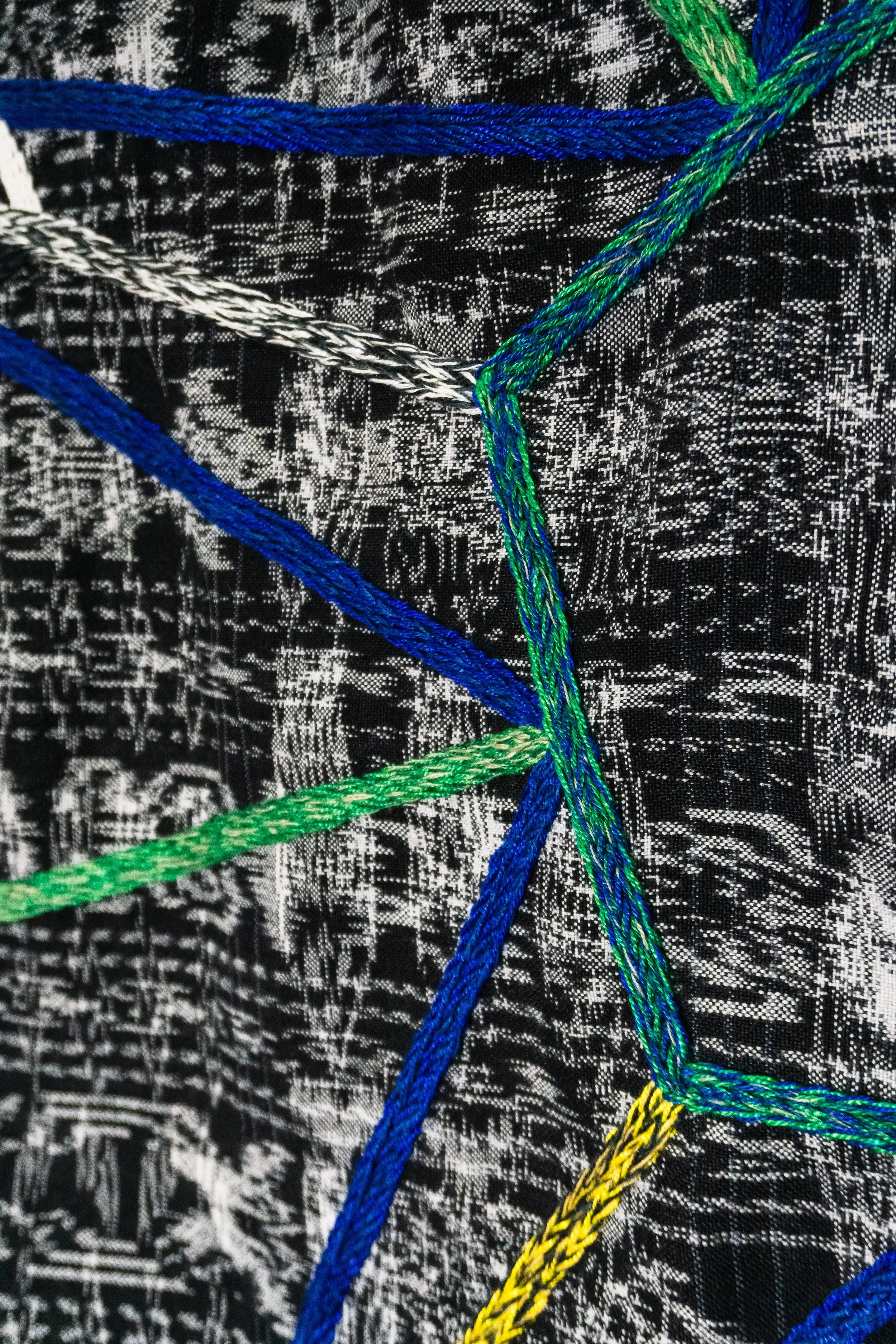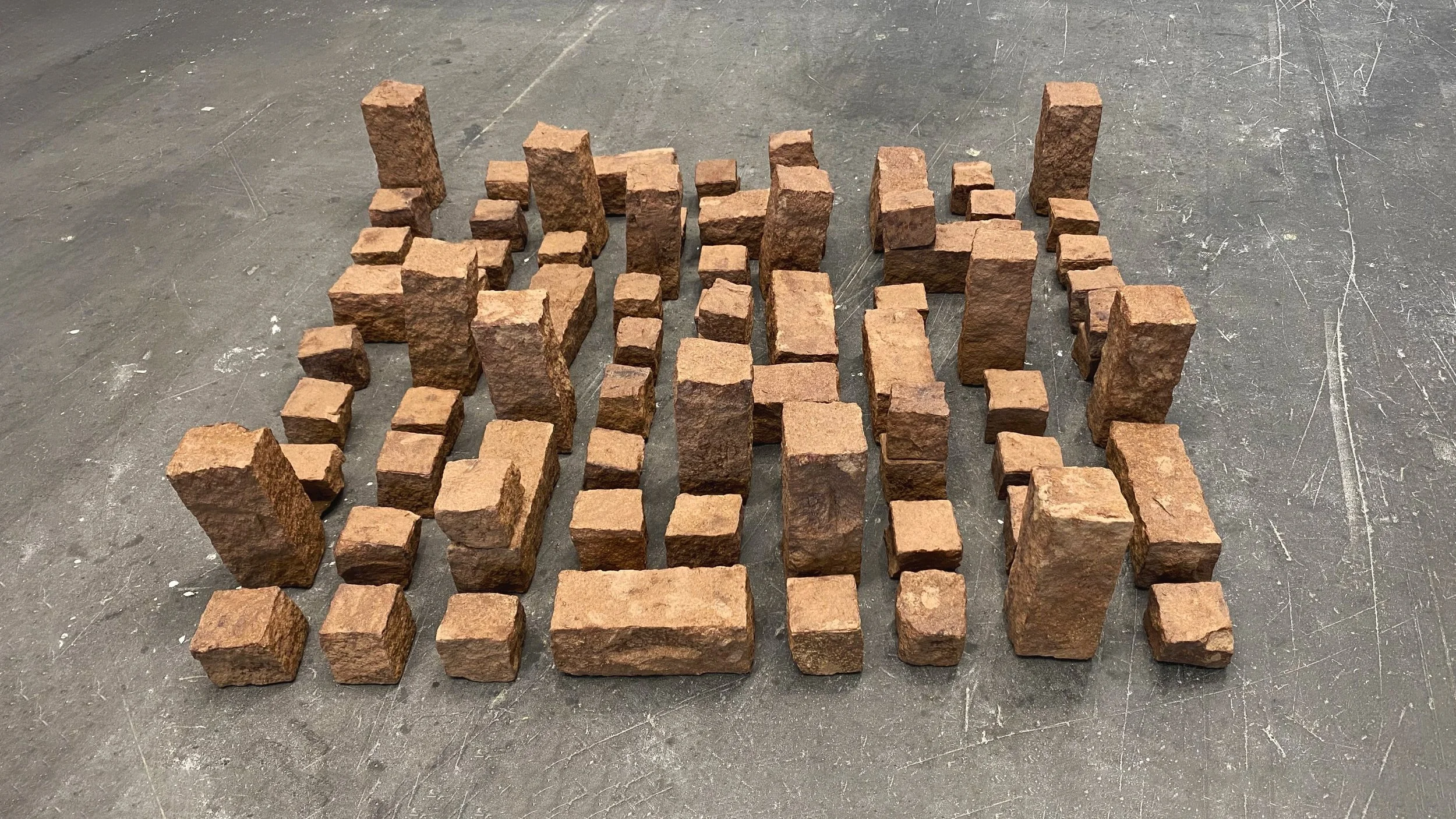LISTE
BASEL 2025
BOOTH 79 | LISTE BASEL 2025
ADÁN VALLECILLO, ANDREA MONROY PALACIOS & JAMIE DENBURG HABIE
For Liste 2025, Galería Extra presents the work of three artists whose practices are driven by the use of natural pigments and their potential as fluctuating layers of the body. Through materials such as cocoa, cochineal, and indigo, these works evoke poetic, sensorial, and political experiences that reflect on the relationship between human beings and their environment. Pigments, understood as a second skin, function as thresholds enabling dialogues between nature, the body, and socioeconomic structures.
Adán Vallecillo questions the dynamics of production, circulation and global consumption by working with cacao, a material deeply rooted in Mesoamerican cosmovisions but decontextualized and transformed into a symbol of consumption in Western markets. His proposal includes covering stones and clay tablets with pure cacao, recovering the ritual qualities of cacao and its links to the territory. This poetic gesture evidences the tensions between ancestral practices and the dynamics of industrial exploitation that characterize its contemporary production. Vallecillo reveals the contradictions of the value systems associated with the material, proposing a return to its original sacredness.
Andrea Monroy Palacios, Flor Estrella C (detail).
Andrea Monroy Palacios weaves a dialogue between the vegetal kingdom and the pollinating beings essential for the reproduction of cocoa. Inspired by the antennae and wings of these small mediators, Monroy Palacios creates hybrid beings that emphasize the interdependence between flora and fauna. Her materials come from her personal garden, an intimate space that serves as both a laboratory for extracting natural dyes and a source of inspiration for her symbolic universe. In her works, the artist replicates and transforms ephemeral architectures built by the creatures in her garden—such as spider webs and pollinators’ micro-ecosystems— drawing parallels between nature’s creative processes and her own.
Jamie Denburg Habie’s Three Bodies explores the relationship between the human body, Earth, and Moon through paintings that function as scores for somatic meditation. The bones woven into the canvas can be read as text, enunciating the “O” shapes as a resonant sound that vibrates in the skull through bone conduction. These bodily vibrations echo the subtle forces between Earth and Moon—not only the Moon’s pull on the Earth, but also Earth’s lesser-known gravitational pull, which creates constant seismic activity on the Moon. Using materials like calcium, present in the skeleton as well as in the Moon’s surface and Earth’s crust, the work traces deep geological kinships while somatizing the rhythms that connect celestial and human bodies.
Together, these three proposals create a visual and conceptual framework that invites the viewer to reconsider their relationship with regional elements and their material memories. The exhibition is conceived as a shroud where natural pigments not only cover, but also reveal the histories, tensions and possibilities inscribed in the bodies and landscapes we inhabit. These pigments, bearers of a pre-Hispanic legacy, are presented as symbols of resistance to the current unequal relations of global production and consumption.
Jamie Denburg Habie, Llena (Partitura para Ver Respirar).
ABOUT THE ARTISTS
BOOTH 79 | LISTE BASEL 2025
ADÁN VALLECILLO, ANDREA MONROY PALACIOS & JAMIE DENBURG HABIE
For Liste 2025, Galería Extra presents the work of three artists whose practices are driven by the use of natural pigments and their potential as fluctuating layers of the body. Through materials such as cocoa, cochineal, and indigo, these works evoke poetic, sensorial, and political experiences that reflect on the relationship between human beings and their environment. Pigments, understood as a second skin, function as thresholds enabling dialogues between nature, the body, and socioeconomic structures.
Adán Vallecillo questions the dynamics of production, circulation and global consumption by working with cacao, a material deeply rooted in Mesoamerican cosmovisions but decontextualized and transformed into a symbol of consumption in Western markets. His proposal includes covering stones and clay tablets with pure cacao, recovering the ritual qualities of cacao and its links to the territory. This poetic gesture evidences the tensions between ancestral practices and the dynamics of industrial exploitation that characterize its contemporary production. Vallecillo reveals the contradictions of the value systems associated with the material, proposing a return to its original sacredness.
Andrea Monroy Palacios, Flor Estrella C (detail).
Andrea Monroy Palacios weaves a dialogue between the vegetal kingdom and the pollinating beings essential for the reproduction of cocoa. Inspired by the antennae and wings of these small mediators, Monroy Palacios creates hybrid beings that emphasize the interdependence between flora and fauna. Her materials come from her personal garden, an intimate space that serves as both a laboratory for extracting natural dyes and a source of inspiration for her symbolic universe. In her works, the artist replicates and transforms ephemeral architectures built by the creatures in her garden—such as spider webs and pollinators’ micro-ecosystems— drawing parallels between nature’s creative processes and her own.
Jamie Denburg Habie’s Three Bodies explores the relationship between the human body, Earth, and Moon through paintings that function as scores for somatic meditation. The bones woven into the canvas can be read as text, enunciating the “O” shapes as a resonant sound that vibrates in the skull through bone conduction. These bodily vibrations echo the subtle forces between Earth and Moon—not only the Moon’s pull on the Earth, but also Earth’s lesser-known gravitational pull, which creates constant seismic activity on the Moon. Using materials like calcium, present in the skeleton as well as in the Moon’s surface and Earth’s crust, the work traces deep geological kinships while somatizing the rhythms that connect celestial and human bodies.
Together, these three proposals create a visual and conceptual framework that invites the viewer to reconsider their relationship with regional elements and their material memories. The exhibition is conceived as a shroud where natural pigments not only cover, but also reveal the histories, tensions and possibilities inscribed in the bodies and landscapes we inhabit. These pigments, bearers of a pre-Hispanic legacy, are presented as symbols of resistance to the current unequal relations of global production and consumption.
Jamie Denburg Habie, Llena (Partitura para Ver Respirar).
ABOUT THE ARTISTS












